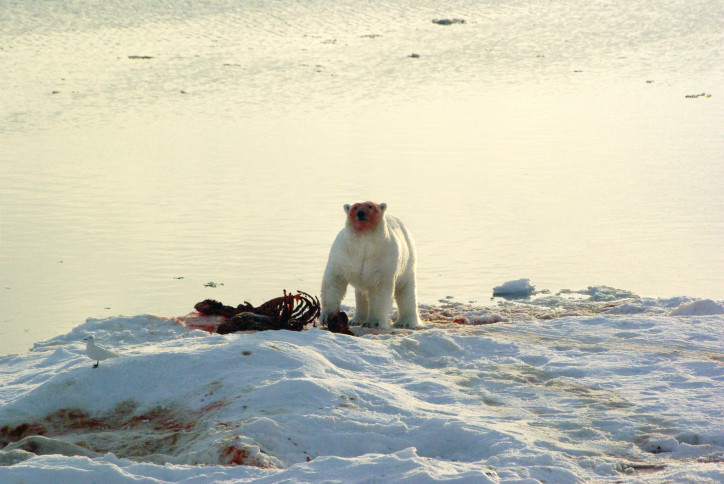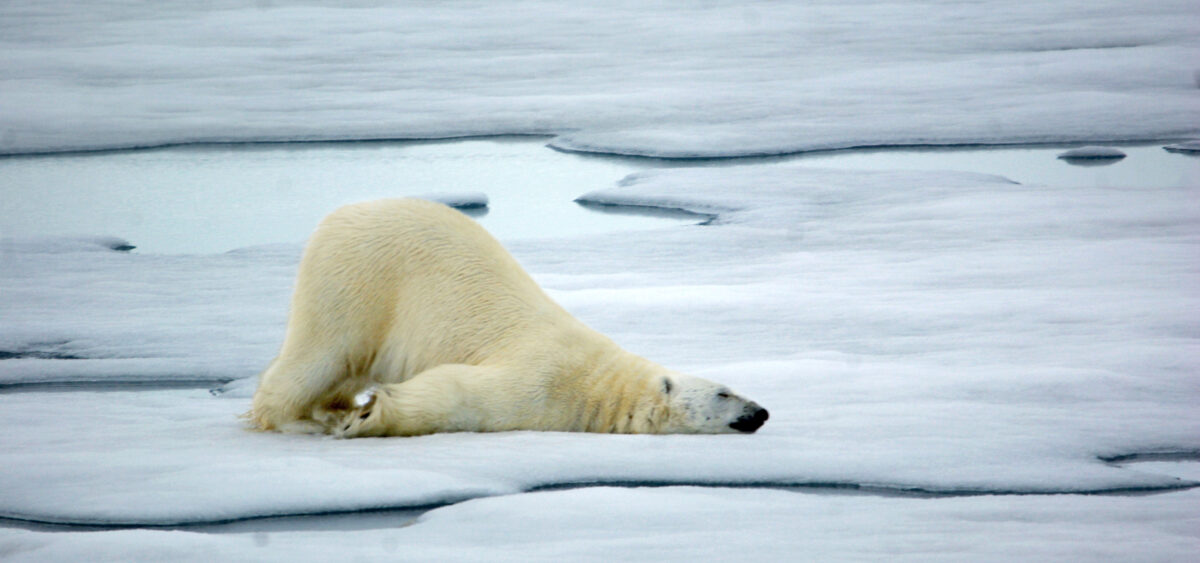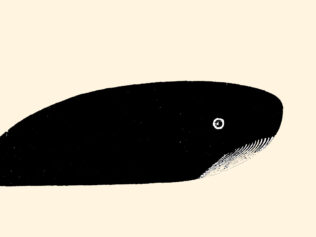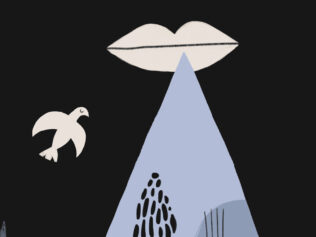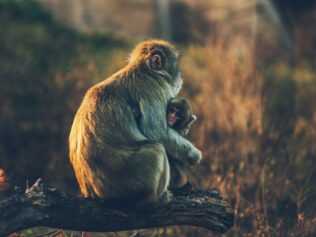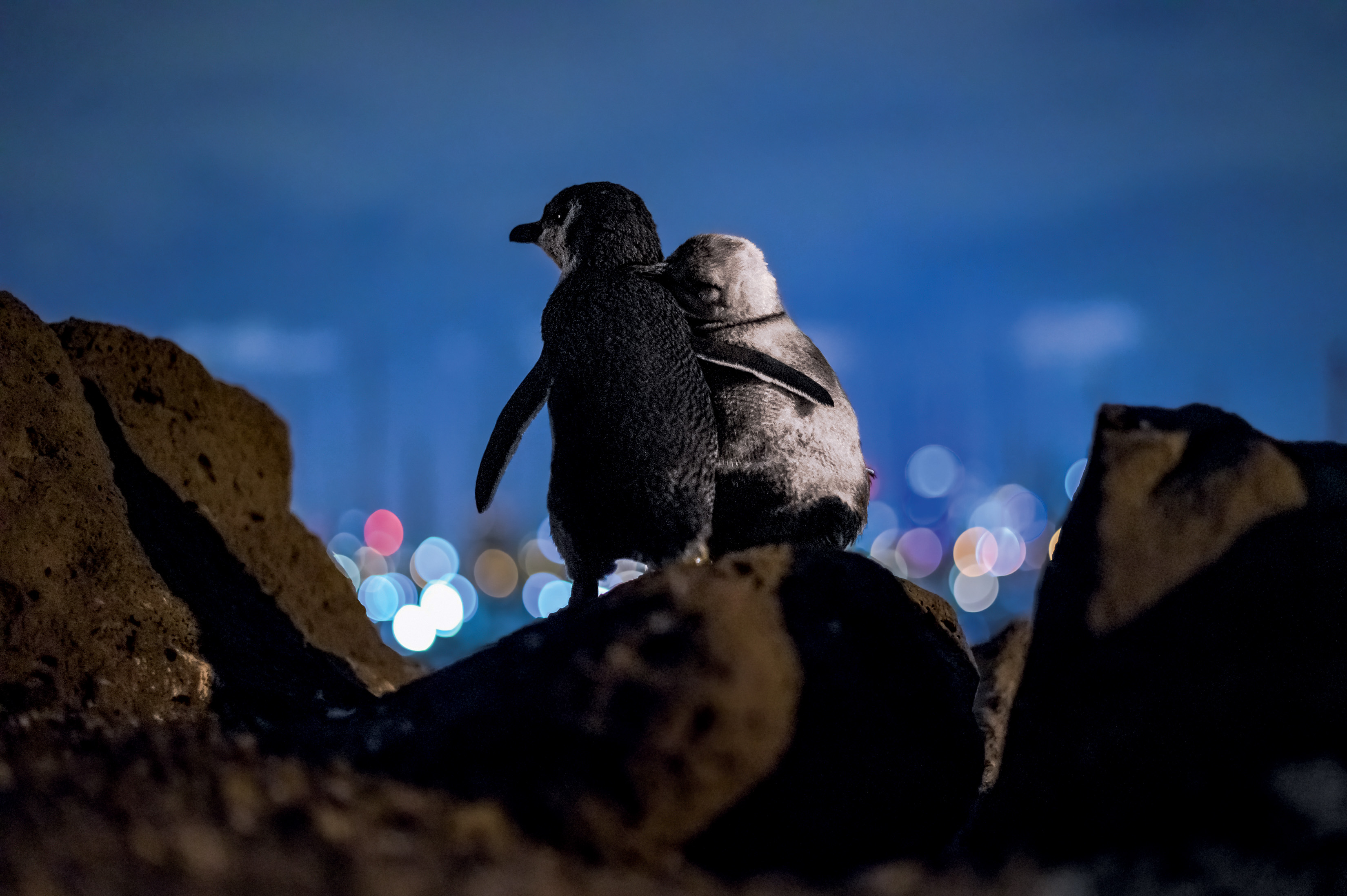
He stood there, sniffing, his massive head turned towards us. We were only separated by two hundred yards of pebbly beach. If the polar bear wanted to, he could catch us within seconds. I hoped he wouldn’t try, because I was adamant about not wanting to shoot it.
Some animals have an extraordinary status in popular culture and provoke special feelings in us. It’s difficult for me to imagine a person who doesn’t like penguins. Even though I’ve seen millions of them, I automatically smile every time I meet one—just like when I saw them for the first time, twenty years ago. The giant panda also brings to mind pure sweetness, as does the koala. Young seals and sea otters affect us so much that even the most hardened scientists (after all, the phrase “cute little creature” doesn’t suit scientific discourse at all) claim that they have an “exceptionally high cuddle factor,” as I once learned from a research paper on the latter. Tigers, lions, and wolves, in turn, inspire admiration and respect, often tinged with a touch of fear.
It might be that among all these pop-cultural icons only the polar bear arouses emotions so completely removed from what they really are. We perceive them as huge white teddy bears, oversized plush toys, and lovable cuties. Meanwhile it is the largest predatory land mammal and the most carnivorous of all bears. If we picked the most terrifying tiger, the biggest lion, and the strongest wolf, a large polar bear would weigh more than all three of them put together—and it’d be able to give each and every one of them a good kicking.
In evolutionary terms, the polar bear is a relatively young species. Its oldest unambiguous fossil is a jawbone found on Svalbard in 2004: it is estimated to be around 110,000 to 130,000 years old, which means that as Homo sapiens, we supposedly “wise” humans are probably older than these imposing predators. But we must remember that polar bear fossils are very rare, because these animals spend most of their lives on the frozen ocean, meaning their bodies normally disappear into the icy depths after they die. The bear’s connection with the ocean is so strong that it is commonly considered to be a marine mammal, which is reflected in its Latin name Ursus maritimus, or sea bear. Usually, however, it moves across hard ground, most often ice, as it hunts seals—the staple of its diet.
Cream, Not White
The polar bear’s closest relative is the brown bear. In his monograph about the species, Christian Kempf writes that over 100,000 years ago a certain brown bear—perhaps a North American grizzly or some specimen from Europe or Asia—was just getting ready to hibernate when it noticed a seal lying on the ice. It went over, ate the seal, and knew that it was good. Then it noticed another one nearby and decided not to sleep, but to continue making use of the abundant food. Kempf phrased it a little differently, but it’s nonetheless a quite accurate description of the probable evolution of polar bears, who really are active throughout the whole year (only pregnant females go into hibernation).
Genetic analysis moves this moment of speciation—i.e., the separation of two evolutionary lines and the formation of distinct species—a bit further back into the past. However, it happened recently enough that both species can still cross-breed, producing fertile offspring. No case of such hybridization is known in Asia or Europe, but in North America the first cross between a polar bear and a grizzly was recorded in 2006. The unfortunate animal was, of course, immediately shot by a gallant hunter; because it didn’t represent either of the two crossed species, no formal regulations were in place to protect it. Later, however, a few other hybrids like this appeared and they even got a name or two of their own: a “pizzly” if the father was a polar bear and the mother a grizzly; a “grolar” if it was the other way around.
We adore definitions because we feel safer in a world where everything is tidily categorized. Unfortunately, nature turns out to be much more complex than we’d like, and it could care less about the definitions and strict divisions humans create. We are taught that disparate species do not cross-breed, and should definitely not produce fertile offspring. If we persist with that definition, we can’t consider polar and brown bears as separate species. Still, we can differentiate them at first glance. Polar bears are larger (only brown bears from the Alaskan Kodiak Island sometimes match their size), their skulls are more elongated, and their fangs and claws are also longer, which adapts them better to a more predatory lifestyle. And, of course, they’re almost white—although in reality their fur is closer to a cream color, or even yellowish.
This camouflage against snow and amid piles of sea ice can be so effective that researchers often have trouble finding them. This is where technology comes in. In the 1980s, a scientist came up with a cunning plan to search for polar bears using equipment which detects heat radiation. It came to nothing, but the process created one of my favorite images: on a purple background there’s a very faint outline of a bear’s silhouette with three red spots on its muzzle and two less distinct ones a bit higher up. It transpired that the bears’ fur insulates them so perfectly that they’re just as elusive in infrared as in visible light. They emit practically no warmth—only from their eyes, nose, and the inside of their auricles.
In the course of evolution, they have also developed clever mechanisms for warming up. Polar bear skin is almost black, so it attracts solar radiation. For a time, there was even a theory that the hairs of their pelt, hollow inside, function like fiber-optic cables which direct the sun’s rays straight to the skin, but this hypothesis—although attractive—was eventually rejected. On sunny days, bears can heat up so much that they must shed some of the warmth. Unfortunately, their fur makes it very difficult, so they can often be seen sliding on their stomachs along ice and snow, to speed up the cooling process. This rolling around also helps keep the fur clean.
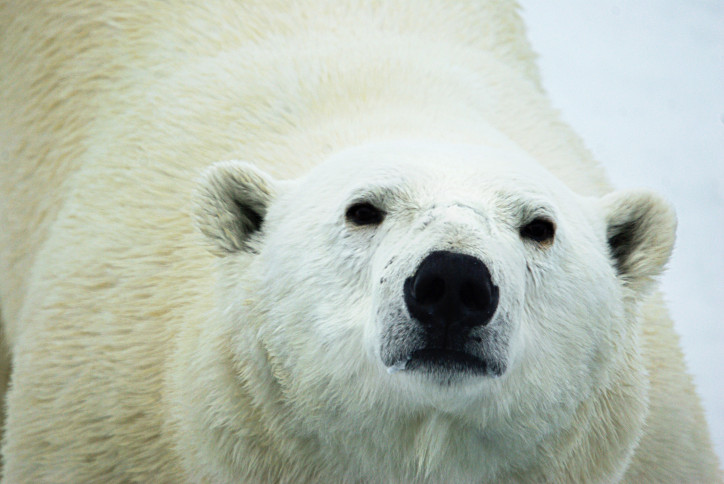
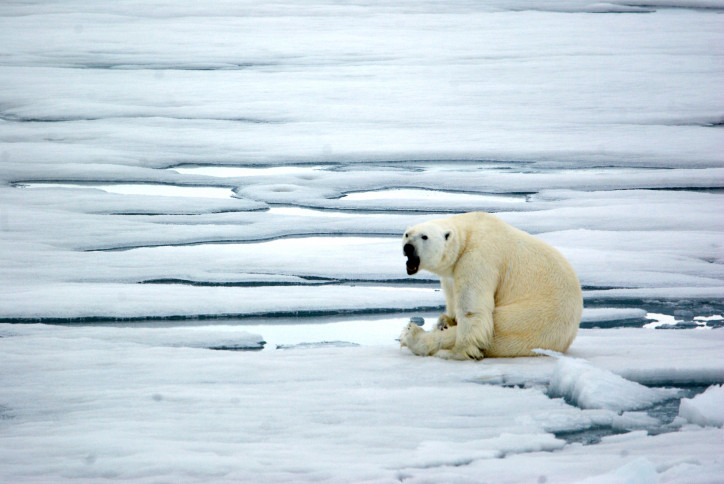

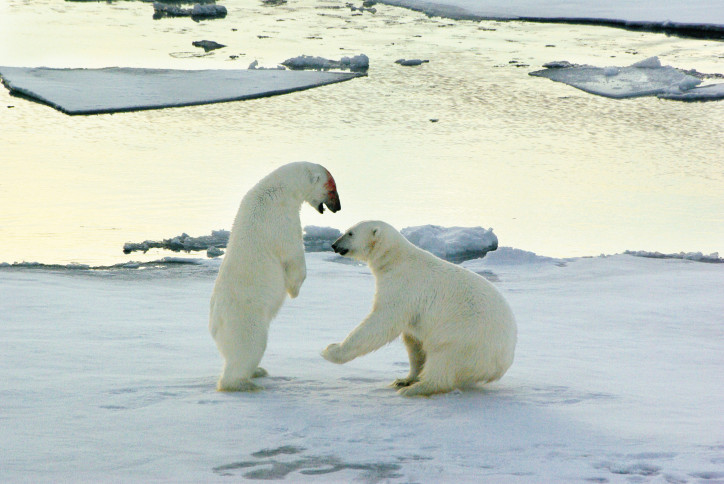
A Stick Against a Giant
Before landing in the Arctic, it is important to closely observe the destination through binoculars, trying to pick out any suspiciously cream-colored shapes among the masses of white snow. Everything butter-colored needs to be carefully inspected. In the places that are visited most often, scientists and other professionals working in the northern polar region already know the location of bear-shaped boulders which have a bit more of a yellow tinge than others. If nothing suspicious can be seen, armed scouts land on the shore and check the surroundings more carefully. Let’s return to the pebbly beach described at the beginning of this article, which I had landed on as part of my work as an Arctic tour guide. This time everything had gone according to procedure—there were no bears around, so we sent guards to a few higher places and started transporting tourists to our destination.
We were watching some walruses having a rest when our ornithologist, Noah, shouted through the radio from the bridge: “A bear! A bear’s just swam across the fjord and got on shore two hundred yards from you!” In the Arctic, you remain constantly vigilant, so I noticed the animal at practically the same moment the alarm sounded. My group was the closest. Alarmed, I watched the enormous, muscular body climb over rocks and scan the area. Thankfully the bear wasn’t interested in us: he turned slowly and walked the other way. We didn’t wait for him to make up his mind, though—with rifles at the ready, we evacuated the beach immediately.
I learned a few lessons that afternoon. First, in a place like the Arctic you can never feel too safe and abandon your vigilance—that’s obvious. Second, as humans, we hardly deserve the arrogant moniker sapiens. Instead of getting out of there swiftly and efficiently, part of the group wanted to stay longer with the walruses, and some guests even turned around to photograph the bear. I understand that they felt like they were at a zoo because the walruses were resting so peacefully, but they should have been well aware that they were not in a playground. And finally, I am always astonished at how the body behaves in such dangerous situations. We organized the evacuation efficiently, quickly, and calmly; it was only back on the ship that I started to shake and it took about half an hour for the adrenaline to fade away.
I don’t know what would have happened if the bear had decided to attack us then. Although I had been thoroughly trained, I would never want to find out whether I am able to use a gun if push comes to shove. I don’t even like having to carry it around with me. But in the Svalbard region it is mandatory; practically every year, tragic encounters with bears take place. As a result, people die often and bears are always killed, even though it’s their turf.
But it doesn’t have to be this way. Nikita Ovsyanikov is one of the world’s most eminent polar bear experts. He’s been studying them for more than thirty years on Wrangel Island. He is a professor in my favorite scientific field, behavioral ecology, which explores why animals behave the way they do. He has also been my colleague for many years and I have admired him the whole time. Among his Arctic coworkers, he’s known as “Nick the Stick,” because he never carries a gun, only a long wooden object. When he started working in the Arctic, he decided that regardless of the situation, he would never shoot at any animals, because they’re on home ground and he is visiting of his own free will.
His position as an expert in behavior and motivation is that like all predators, polar bears are both curious and careful. Predators must look for new opportunities, but at the same time they must make sure not to get hurt, as that would make hunting impossible. Hence Nikita’s opinion is that if he gives the bear a clear signal that he is not prey, the king of the Arctic will not bother him. He is no giant, but a rather small man—still, he looks like he’s carved (although not very precisely) out of wood. I saw him once in action among Antarctic fur seals. When a huge, raging male charged at him, Nikita showed the power of non-verbal communication. Non-human animals are much more sensitive to it, because they’re unable to make precise verbal utterances. I can handle a 450-pound fur seal with huge tusks, but usually I have to raise my hands or insult it loudly, making use of the fact that I’m often the only Pole in the vicinity (I’ve discovered that Antarctic fur seals have a perfect understanding of Polish swear words). But Nikita just stood there, and—at the crucial moment—simply made a short gesture, shoving his shoulders to the front. I had never seen a male fur seal run away from anyone so quickly.
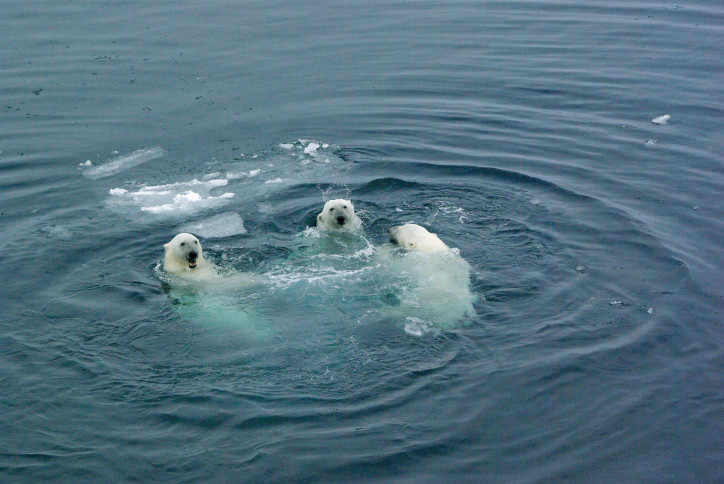
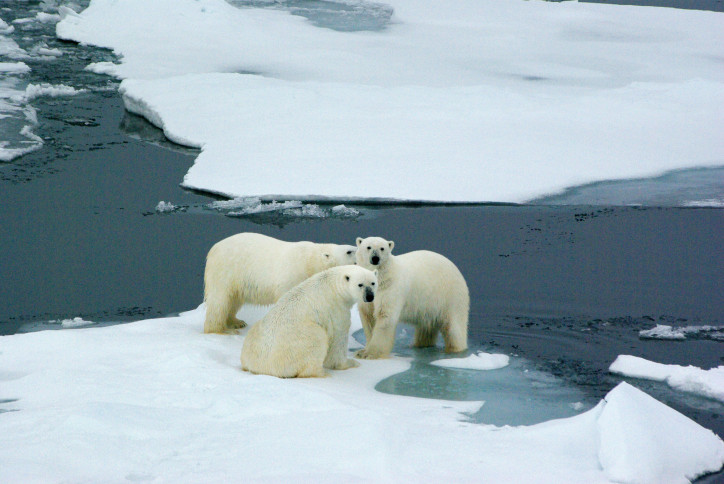
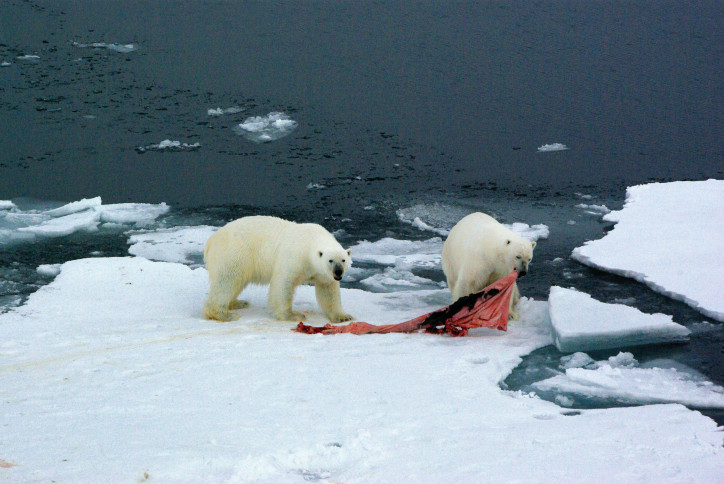
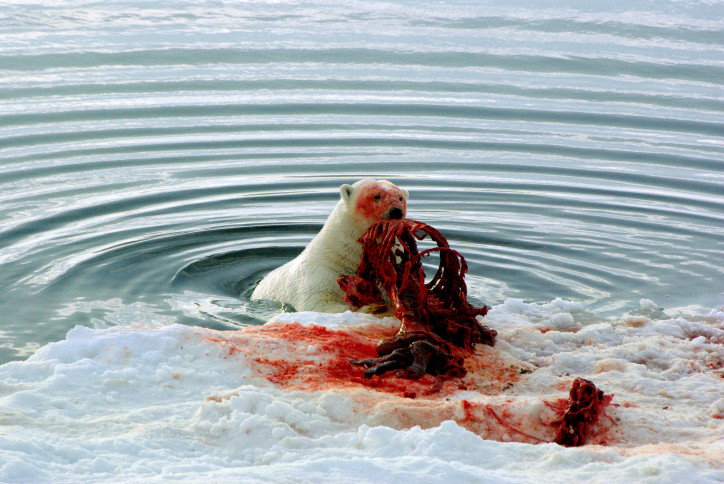
Nikita is able to send a similarly effective body language message to let bears know not to cross him. If the predator gets too close despite this, my colleague pokes it lightly in the chest with his stick, because—as he claims—they “really don’t like it; they’re afraid of these kinds of pointy, long objects, maybe they remind them of walrus tusks.” If this doesn’t work, Nick the Stick reaches for the final tool: pepper spray, which, while not dangerous to bears, is very unpleasant. According to Nikita, the spray also has another big advantage over guns in that bears learn to avoid it, and can later pass that knowledge onto their young (you just really have to remember which pocket holds the spray). After being in contact with a gun, they no longer have that opportunity. What’s more, we send mixed signals to the animal when we use a gun: we raise it to our eye, we lower it, lift it again—all of which signifies uncertainty. And that is interpreted as fear, or an invitation to hunt us. Nikita has had over four thousand encounters with bears in his life, but he’s only had to use the spray four times. According to him, those four situations resulted from his stupid mistakes—either he lay down too long filming the bears, or he withdrew too quickly, as if running away. It’s incredible that he can put his theoretical knowledge of animal behavior so bravely and efficiently into practice.
Bear Life
If bear life is going well, males court females from spring to midsummer. At the end of November and the beginning of December, pregnant females enter cleverly constructed dens, most often burrows dug into a snowy mountainside, equipped with a ventilation shaft. The future mothers stay there, and around January they give birth to adorable babies that weigh less than two pounds. Interestingly, the female is asleep the whole time, and when she wakes around February or March, the young have grown a little and are ready to play— an enviable position for the mother. In the spring, the female bear digs herself out of the den and must quickly obtain food. If everything goes to plan, the young will be with her for almost three years. This has interesting implications, because every female can think about another litter only once every three years, so in each breeding season only one third of females is ready to procreate—all the others are busy rearing their offspring. This means that although the population includes roughly equal numbers of males and females, due to the so-called “operational sex ratio” males outnumber females by three to one. This is why they become fiercely competitive—and thus grow to enormous sizes. Usually, they weigh around 1,500 pounds and measure up to ten feet, but the largest individual ever hunted weighed around 2,200 pounds and was eleven feet long. Females are less than half the size.
Only a small proportion of the cubs makes it to adulthood. Most of them die of hunger or in accidents, or get hunted down by a ravenous male. Adults can lose their life in a fight with another polar bear or with a walrus. But if this doesn’t happen, they can live for over thirty years. Of course, the accelerating climate catastrophe is hugely affecting the bears’ survival rate. Sea ice is decreasing; it now forms later and later in the autumn and disappears earlier and earlier in the spring. These remarkable animals can survive even a few months starving and waiting for conditions to improve, but currently the wait is becoming too long. This is accompanied by pollution which accumulates to dangerous levels in the tissues of bears as apex predators, i.e., those at the top of the food chain.
It is estimated that as a result of these factors, the current global population of polar bears, thought to be between 22,000 and 31,000, will reduce by around 70 percent by 2050. But despite the seriousness of the situation, hunters keep killing bears—it’s the main cause of death among adults. Some hunters are Inuit, but not all of them. It could be debated whether Inuit hunting is a tradition worth continuing, because apart from one group—which lived ten thousand years ago on a small island on the Siberian coast—no Indigenous community was ever dependent on polar bears; they were desired, but by no means essential. Unfortunately, however, Inuit have the right to sell off their allocation of bear shooting, which means that commercial hunts by trophy hunters arriving from the south take the bloodiest toll. I find this repulsive.
In his slim but very substantial book Polar Bears on the Edge: Heading for Extinction while Management Fails, Morten Jørgensen emphasizes that population numbers in places where bears can still be hunted are overestimated due to animal migration. Unlike their darker cousins, polar bears are not territorial and roam freely in search of food. Which is why they move from uninhabitable areas to places which are temporarily better, where it might seem like there’s more of them. But this does not mean that they can be shot at with impunity. It is only surprising that many of the largest organizations in the field of ecology, such as the WWF, are still against placing polar bears under complete protection—allegedly so that Indigenous traditions can be nurtured. As a result, about a thousand of these animals are killed annually.
If we put a stop to the hunting, would this species be able to survive climate collapse? In the short history of their evolution, polar bears have demonstrated unique flexibility. They have already made it through a few climate changes. Undoubtedly, their high intelligence helped. Scientists have recently admitted that there may be truth to Inuit legends, known for over a century, about how bears use tools. It transpires that when hunting huge, strong walruses, bears sometimes throw ice blocks at them or drop stones on their heads in order to politely knock them out or even kill them. Last year sensational videos from the Polish Arctic station in Hornsund on Spitsbergen went around the world: for the first time in history, a bear was filmed hunting a reindeer in a novel way. Bears are fast, but on land reindeer turn out to be faster. However, this time (and later, a few more times) the predator cornered its victim on a narrow point, forcing it into the sea, where the reindeer had no chance.
Nature conservation specialists correctly claim that if we cannot save the most iconic species—some of which I mentioned at the beginning of this article—then other animals which don’t make us so emotional stand even less of a chance. I hate the thought that at some point during visits to high schools and kindergartens I’d have to talk about polar bears in the past tense. The drastically changing world puts enormous pressure on these remarkable animals, and we certainly don’t help them survive by hunting them.
Once, on a ship, I met a man who had shot a polar bear for sport. As he claimed, the individual was old, didn’t procreate anymore, and was of no significance to the population. Of course, the trophy hunter had heard this from guides who were very interested in his money. As a tourist guide, I have a lot of practice in being polite to my guests. I think that showing people wild, unique, and endangered places may help save them. But at that moment I couldn’t hold back. I didn’t grace his bragging with a comment, I just looked at him and asked about his age. He was well into his seventies and went purple with outrage. It certainly wasn’t a polite question on my part, but I don’t regret it.
Scenes from the lives of polar bears were documented (at a respectable distance) by the author of this article, Mikołaj Golachowski. The photos were taken in 2007 and 2015 during trips to the North Pole and in Canada.
